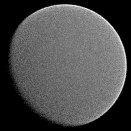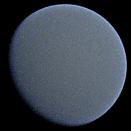Hubble Space Telescope (HST) Model Images of Mars
First, here
is a web site with lots of neat HST images of Mars. Now, here
is one of our models: Cool, huh? We took
a surface reflectance map at a wavelength of 1042 nanometers from
Bell et al. (1997 JGR, 102, 9109-9124). The model atmosphere has
a dust optical depth of 0.4. Subsolar and Subearth points are
arbitrarily chosen to be (lat=25 deg.,lon=80) and (lat=25,lon=40)
respectively.
Cool, huh? We took
a surface reflectance map at a wavelength of 1042 nanometers from
Bell et al. (1997 JGR, 102, 9109-9124). The model atmosphere has
a dust optical depth of 0.4. Subsolar and Subearth points are
arbitrarily chosen to be (lat=25 deg.,lon=80) and (lat=25,lon=40)
respectively.
An example of an initial study we are undertaking is to model
atmospheric Ozone abundances of Mars by comparing models to HST
images taken in the Hartley band (255 nm). Below is a model of
the martian atmosphere that contains carbon dioxide (CO2) and
ozone (O3) at a wavelength of 255 nanometers. As the ozone absorption
increases to the right, the mars disk gets slightly darker. The
image on the far right is a 3-color (Blue Green Red) combination
of the images on the left. It's mostly blue because the first
image is much brighter than the other two. Note, these are run
at the same spatial resolution as HST WFPC2 camera, but they haven't
been convolved with the HST point-spread-function. Note also that
we use a constant surface albedo so there are no surface features
in these models.
Varying Ozone (O3) levels
 |
 |
 |
 |
|
O3 (micron-atm) |
0 |
2 |
4 |
|
ave albedo |
1 |
0.37 |
0.23 |
|
normal optical depth |
0.064 |
0.121 |
0.179 |
Here's pixel-wide slices across the surface of the disks of
the 3 images, just showing the limb area. The images were convolved
with a voigt function that resembles HST PSF, before slicing.

Our study will focus on the limb, that is, the outer edge of the
atmosphere, where we can see a large effect and as affected from
the uncertainties of the surface properties. The multi-year coverage
of the HST data (1995-7) will provide information about the latitudinal,
seasonal, and interannual variations of Martian ozone column densities.
We will focus our efforts on the period from late spring through
the end of summer (in the northern hemisphere), with special attention
given to low-to-mid latitude regions where the knowledge is very
incomplete.
 return to B.
Whitney's Mars page
return to B.
Whitney's Mars page
 return to B.
Whitney's homepage
return to B.
Whitney's homepage
 Cool, huh? We took
a surface reflectance map at a wavelength of 1042 nanometers from
Bell et al. (1997 JGR, 102, 9109-9124). The model atmosphere has
a dust optical depth of 0.4. Subsolar and Subearth points are
arbitrarily chosen to be (lat=25 deg.,lon=80) and (lat=25,lon=40)
respectively.
Cool, huh? We took
a surface reflectance map at a wavelength of 1042 nanometers from
Bell et al. (1997 JGR, 102, 9109-9124). The model atmosphere has
a dust optical depth of 0.4. Subsolar and Subearth points are
arbitrarily chosen to be (lat=25 deg.,lon=80) and (lat=25,lon=40)
respectively.



